
Anna Ancher was a Danish artist associated with the Skagen Painters, an artist colony on the northern point of Jylland, Denmark. She is considered to be one of Denmark's greatest visual artists.

Johan Ludwig Gebhard Lund was a Danish painter, born in Kiel, Duchy of Holstein, to master painter Hans Giewert Lund and his wife Maria Magdalena Christina Bremer. An adherent of romanticism, he is known for his history paintings.
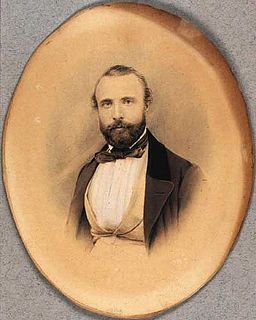
Johan Julius Exner,, Danish genre painter, was born in Copenhagen to Johann Gottlieb Exner, a Czech musician from Bohemia, who came to Denmark during the Napoleonic period, and his wife Karen Jørgensdatter. Exner originally intended on becoming a history painter, but quickly found his niche, however, in genre painting, the most popular and lucrative painting style of his era. His genre paintings figured prominently in Denmark's National Romantic period, an artistic period directly after the Golden Age of Danish Painting, when artistic focus was turned inwards to uniquely Danish themes.
Per Kirkeby was a Danish painter, poet, film maker and sculptor.
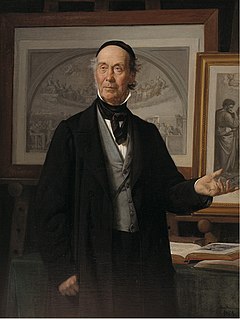
Niels Laurits Andreas Høyen is considered to be the first Danish art historian and critic. He promoted a Danish nationalistic art through his writings and lectures, and exerted a far reaching effect on contemporary artists. His work in various cultural institutions helped steer the development of Danish art during the mid-19th century.
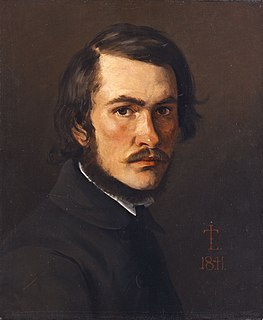
Johan Thomas Lundbye was a Danish painter and graphic artist, known for his animal and landscape paintings. He was inspired by Niels Laurits Høyen's call to develop nationalistic art through depictions of Denmark's characteristic landscapes; the historical buildings and monuments, and the country's simple, rural people. He became one of his generation's national romantic painters, along with P. C. Skovgaard and Lorenz Frølich, to regularly depict the landscape of Zealand.

Laurits Andersen Ring was one of the foremost Danish painters of the turn of the 20th century, who pioneered both symbolism and social realism in Denmark. Considered one of the masterpieces of Danish culture, his painting Summer Day by Roskilde Fjord was included in the 2006 Danish Culture Canon.

The National Gallery of Denmark is the Danish national gallery, located in the centre of Copenhagen.

Danish art is the visual arts produced in Denmark or by Danish artists. It goes back thousands of years with significant artifacts from the 2nd millennium BC, such as the Trundholm sun chariot. For many early periods, it is usually considered as part of the wider Nordic art of Scandinavia. Art from what is today Denmark forms part of the art of the Nordic Bronze Age, and then Norse and Viking art. Danish medieval painting is almost entirely known from church frescos such as those from the 16th-century artist known as the Elmelunde Master.

Viggo Thorvald Edvard Weie was a Danish Modernist painter. He was a recipient of Eckersberg Medal in 1925. He died during 1943 in Frederiksberg.

Agnes Slott-Møller, née Rambusch, was a Danish Symbolist painter; influenced by the Pre-Raphaelites. She is known for works inspired by Danish history and folklore. Her husband was the painter Harald Slott-Møller.
Richard Winther was a Danish artist. His career focused mainly on painting, graphics, photography and sculpture. Richard's work was greatly influenced by Asger Jorn and Richard Mortensen, both Danish artists part of the Linien group.
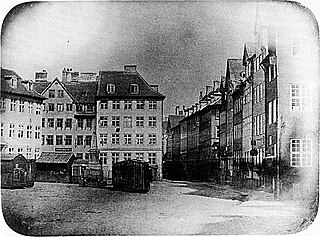
Photography in Denmark has developed from strong participation and interest in the very beginnings of the art in 1839 to the success of a considerable number of Danes in the world of photography today.
Merete Barker is a Danish artist who uses sketches and photographs from her many travels as the basis for highly expressive paintings where it is often difficult to distinguish between nature and culture.
The Danish Culture Canon consists of 108 works of cultural excellence in eight categories: architecture, visual arts, design and crafts, film, literature, music, performing arts, and children's culture. An initiative of Brian Mikkelsen in 2004, it was developed by a series of committees under the auspices of the Danish Ministry of Culture in 2006–2007 as "a collection and presentation of the greatest, most important works of Denmark's cultural heritage." Each category contains 12 works although music contains 12 works of score music and 12 of popular music and the literature section's 12th item is an anthology of 24 works.

Sommerdag ved Roskilde Fjord is an oil painting by the Danish artist L. A. Ring from 1900. Considered to be one of the masterpieces of Danish culture, it was included in the 2006 Danish Culture Canon. It is displayed in the Randers Museum of Art.
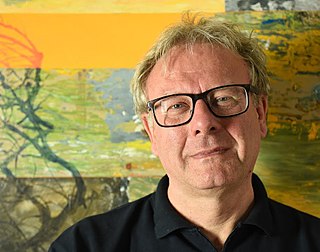
Lars Physant lives and works in Barcelona since 1994, is a Danish painter whose conceptual expression has its roots in naturalism and realism. Amongst his earliest influences are C.W. Eckersberg, Christen Købke, J.Th. Lundbye, Wilhelm Hammershøi, Vermeer van Delft, Claude Monet and Georges Seurat. He is especially known for his royal portraits and his concept of Multiversal Realism expressed on relief structures of wood.
Harald Rudyard Engman (1903-1968) was a Danish artist, painter. Above all, he is remembered for his fierce use of satire in criticizing and resisting the German occupation of Denmark during World War II.
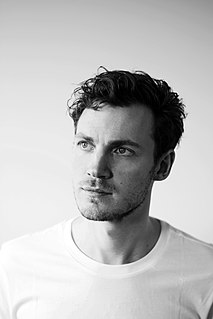
Johannes Holt Iversen is a Danish painter and sculptor currently located in Amsterdam, Netherlands. He is an apprentice of Danish painter and sculptor Erik Rytter.
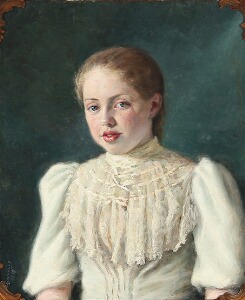
Marie Henriques was a Danish painter who created landscapes, figure paintings and portraits, initially in the Realist style but increasingly under the influence of Impressionism. She also painted watercolours of ancient architecture and sculpture. In 1916, she was a founding member of the Society of Women Artists .














